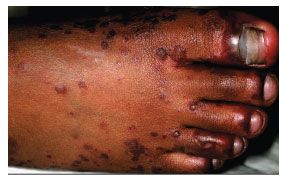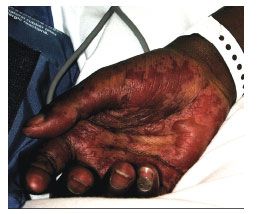- Clinical Technology
- Adult Immunization
- Hepatology
- Pediatric Immunization
- Screening
- Psychiatry
- Allergy
- Women's Health
- Cardiology
- Pediatrics
- Dermatology
- Endocrinology
- Pain Management
- Gastroenterology
- Infectious Disease
- Obesity Medicine
- Rheumatology
- Nephrology
- Neurology
- Pulmonology
Stevens-Johnson Syndrome Associated With Thalidomide Treatment in HIV Infection
A 14-year-old boy of African origin with HIV infection presented to the emergency department complaining of sore, swollen eyes and a sore throat. His antiretroviral treatment at that time consisted of lopinavir/ ritonavir and abacavir/lamivudine fixed-dose combination.
A 14-year-old boy of African origin with HIV infection presented to the emergency department complaining of sore, swollen eyes and a sore throat. His antiretroviral treatment at that time consisted of lopinavir/ritonavir and abacavir/lamivudine fixed-dose combination. His plasma HIV RNA level has been undetectable for the past 2 years, and his CD4+ cell count has been consistently within the normal range (from 920/µL to 1210/µL). Ten days earlier, he began thalidomide therapy for recurrent mouth ulcers.
On examination, the patient had bilateral, nonpurulent conjunctivitis and mild pharyngitis. He was afebrile and appeared otherwise well. Findings from the remainder of the examination were unremarkable. He was discharged home with the presumptive diagnosis of viral infection.
The boy returned 12 hours later with severe periorbital swelling and was unable to open his eyes. He had clear discharge from both eyes and severe conjunctivitis. There were multiple blisters on his lips and oropharyngeal mucosa, with several crusted lesions around his mouth. He had multiple bright red macular lesions on his hands and feet (Figure 1), which resembled target lesions in some areas.

Figure 1. Macular and vesicular lesions on the dorsal aspect of the foot of a 14-year-old HIV-infected boy with Stevens-Johnson syndrome following treatment with thalidomide.
Stevens-Johnson syndrome was diagnosed, and the patient was hospitalized for further management. Thalidomide therapy was stopped, but his antiretroviral regimen was continued. Intravenous fluids were given because he was unable to swallow, and pain relief was provided (paracetamol and ibuprofen). He also received 1 dose of intravenous immunoglobulin.
Over the next day, he complained of worsening pain, requiring treatment with morphine, and widespread, large blisters developed on his palms (Figure 2) and soles. The boy subsequently made a slow but continuous recovery without further alteration in management. He was discharged after 10 days, having reestablished adequate oral intake, without residual problems.

Figure 2. Palmar macular and bullous lesions in a 14-year-old HIV-infected boy with Stevens-Johnson syndrome following treatment with thalidomide.
Stevens-Johnson syndrome and toxic epidermal necrolysis are rapidly progressive conditions character ized by epidermal detachment and mucosal involvement. The majority of cases are drug-induced, with anticonvul sants and antibiotics as the most commonly implicated agents.1 In Stevens-Johnson syndrome, up to 10% of the body surface area is affected, while toxic epidermal necrolysis is defined as involvement of more than 30%.2 The mortality rate is about 1% to 5% and up to 30% for Stevens-Johnson syndrome and toxic epidermal necrolysis, respectively.2
Stevens-Johnson syndrome and toxic epidermal necrolysis are very rare phenomena, with an estimated incidence of around 2 cases per 1 million persons per year.2 However, previous data suggest that Stevens-Johnson syndrome and toxic epidermal necrolysis occur more frequently in HIV-infected persons, possibly as a result of immune dysregulation.2 Several reports have also highlighted the association between Stevens-Johnson syndrome and nevirapine therapy.3-6
In our patient, thalidomide was the likely causative agent, although an intercurrent infection as a potential trigger cannot be ruled out with absolute certainty. Thalidomide is a potent immunomodulatory agent that inhibits tumor necrosis factor-α production. Previous data from randomized, placebo-controlled trials in HIV-infected patients with aphthous mouth ulcers confirmed the effectiveness of thalidomide in this setting (as reviewed by Jacobson7).
Interestingly, one study investigated thalidomide as a treatment option for toxic epidermal necrolysis, with the hypothesis that its anti-inflammatory properties may improve outcome.8 The trial was terminated prematurely because exposure to thalidomide was found to lead to an unexpected increase in mortality. In retrospect, that finding is not very surprising because thalidomide was subsequently found to be etiologically implicated in several cases of Stevens-Johnson syndrome or toxic epidermal necrolysis.9
Thalidomide is a valuable drug in the management of mucosal ulceration in persons with HIV infection. However, health care providers need to be aware of the risk of Stevens-Johnson syndrome and toxic epidermal necrolysis as potential complications of thalidomide therapy, and there should be a low threshold to discontinue treatment if unexplained cutaneous, mucosal, or conjunctival signs develop.
References:
References1. Chan HL, Stern RS, Arndt KA, et al. The incidence of erythema multiforme, Stevens-Johnson syndrome, and toxic epidermal necrolysis. A population-based study with particular reference to reactions caused by drugs among outpatients. Arch Dermatol. 1990;126:43-47.
2. French LE. Toxic epidermal necrolysis and Stevens Johnson syndrome: our current understanding. Allergol Int. 2006;55:9-16.
3. Fagot JP, Mockenhaupt M, Bouwes-Bavinck JN, et al; EuroSCAR Study Group. Nevirapine and the risk of Stevens-Johnson syndrome or toxic epidermal necrolysis. AIDS. 2001;15:1843-1848.
4. Pollard RB, Robinson P, Dransfield K. Safety profile of nevirapine, a nonnucleoÂside reverse transcriptase inhibitor for the treatment of human immunodeficiency virus infection. Clin Ther. 1998;20:1071-1092.
5. Barner A, Myers M. Nevirapine and rashes. Lancet. 1998;351:1133.
6. Mockenhaupt M, Viboud C, Dunant A, et al. Stevens-Johnson syndrome and toxic epidermal necrolysis: assessment of medication risks with emphasis on recently marketed drugs. The EuroSCAR-study. J Invest Dermatol. 2008;128:35-44.
7. Jacobson JM. Thalidomide: a remarkable comeback. Expert Opin Pharmacother. 2000;1:849-863.
8. Wolkenstein P, Latarjet J, Roujeau JC, et al. Randomised comparison of thalidomide versus placebo in toxic epidermal necrolysis. Lancet. 1998;352:1586-1589.
9. Clark TE, Edom N, Larson J, Lindsey LJ. Thalomid (Thalidomide) capsules: a review of the first 18 months of spontaneous postmarketing adverse event surveillance, including off-label prescribing. Drug Saf. 2001;24:87-117.
